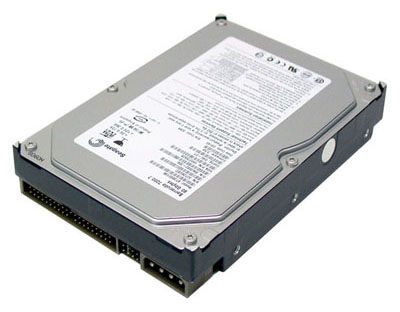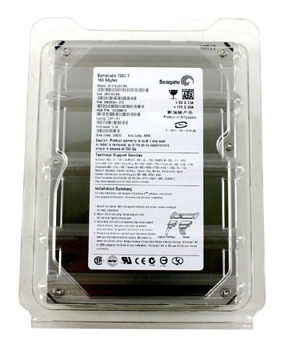Buyer's Guide - Entry Level, October 2004
by Jarred Walton on October 6, 2004 12:05 AM EST- Posted in
- Guides
Hard Drives
As with most of the other options, there are tons of potentially good hard drive choices. The three main factors that influence hard drive performance are the RPM, the amount of cache, and the capacity. While many might insist on a drive with 8 MB of cache, it is not strictly required for the budget segment, and getting a 2 MB cache drive can save you about $10. Getting a 5400 RPM drive instead of a 7200 RPM drive, on the other hand, is not recommended.The question of how much capacity you need is really up to the individual. Some people would never even manage to fill a 20 or 30 GB drive, while for others, even 200 GB may not be enough. These days, the cheapest hard drives still tend to cost about $50, and anything smaller than 40 GB will not be any cheaper. In fact, 80 GB drives are only slightly more expensive than 40 GB drives, and we feel that the extra $10 is worth it to double your capacity.
With most hard drives now spinning at 7200 RPM or faster, noise has become more of a concern. Particularly with an office computer, many people will find high noise levels to be distracting. Earlier 7200 RPM drives have been known to have a high pitch whine. Most companies have now upgraded to the latest spindle technology known as fluid dynamic ball bearings, which help to all but eliminate the noise of the hard drive. Many Western Digital Caviar and Maxtor drives use the older bearings and so, unless noise does not bother you, we recommend that you search out a drive that uses the fluid dynamic bearings. This is available on Hitachi, Maxtor, Samsung, Seagate, and Western Digital drives now, but take some time to make certain that it is on the model that you are purchasing.
One trend that we are happy to see is the return of longer warranties. For a while, many companies were shifting to 1-year warranties. Now, most of them have returned to 3- or even 5-year warranties on their drives. Seagate has led the way with a standard 5-year warranty on all of their models, including previously purchased drives! Others have only increased their warranty on current models. Just remember that the warranty only covers the physical hard drive, so you still need to make backups of your important files.
The final topic relating to hard drive choice is the interface. Parallel ATA - also called IDE or EIDE - has been around for a long time, so it tends to be slightly cheaper. The budget office motherboard that we recommended does not support anything else, but the gaming motherboard offers support for up to two Serial ATA connections. There is little to no difference in real world performance between the interfaces, at least in the budget segment, but SATA does use a thinner cable that is easier to work with. All things being equal, we would prefer a SATA drive over a PATA drive, and we would even be willing to pay a little more for it if necessary.

Office Hard Drive Recommendation: Seagate 80 GB 7200 RPM 8MB PATA
Price: $67 shipped
With all the considerations listed above, it is difficult to argue with the choice of a Seagate hard drive. You get the full five-year warranty (two years more than most of the competition), quiet operation, good performance, and plenty of storage. You could save a few dollars by choosing some alternative, but it just does not make a lot of sense. Should you need more storage space, models with 120 GB and 160 GB are available and have a lower cost per GB, but 80 GB should be plenty for even the most demanding office work.

Gaming Hard Drive Recommendation: Seagate 160 GB 7200 RPM 8MB SATA
Price: $107 shipped
Our recommendation for budget gamers remains with Seagate, due to their impressive set of features and reliability. The difference is that we have chosen to go with a SATA drive instead of PATA, and we have increased the recommended capacity to 160 GB. That may seem like overkill, but when you consider that Far Cry, Unreal Tournament 2004, and Doom 3 all require about 4 GB of hard drive space - and that's without any of the extra content that you can find online - it is very easy to run out of storage for your games. If you uninstall games that you are not currently playing, you can get around this potential difficulty, but that is not the most convenient of solutions. You can always downgrade to a 120 GB or 80 GB drive if you disagree. The cost per GB of an 80 GB SATA drive is 89 cents, while the cost per GB of the 160 GB drive is 71 cents. If you can afford it, you get double your storage space for about a 50% price increase.










53 Comments
View All Comments
skittlekiller - Wednesday, October 6, 2004 - link
One thing that may be useful to inform buyers of is Miscrosoft's basic $15 optical mouse. I work with these very often, I find them to almost compete with Mice like my personal MX510. They're very nice, comfortable, and cheap. They'll do everything you want them to do, and will last you forever.JarredWalton - Wednesday, October 6, 2004 - link
ksherman - even inexpensive SFF cases can cost $200 or more, and they are usually more difficult to work with (since they're cramped). For first time buyers, it is difficult to recommend a SFF. If you know what you're doing, though, go for it. We're still looking into recommendations for a SFF System. Stay tuned.We could also cut the gaming system down to $750 while sticking with the 9800 Pro if we go with a cheaper case, monitor, 80GB HDD, and socket A. The performance will suffer a lot, though, especially in the most recent games. A 9800 Pro is still 50% faster (or more) than a 9600XT, so the extra $70 is money well spent, especially if you have any interest in gaming. If you get a 9600XT, high detail modes really are not an option for the latest generation games (Doom 3, HL2, Far Cry, etc.) That's just our opinion, though, and we do mention the 9600 Pro/XT as an option.
JarredWalton - Wednesday, October 6, 2004 - link
I made a few minor tweaks after reading the comments. I remember reading before that the A7N8X-X was single-channel only, but it's easy to forget with the similarity in names. Still, it's not like the single-channel mode really hurts performance, but with the suggestion of dual-channel RAM, we ought to stick with a board that supports the feature. Sorry for the confusion.Regarding case and monitor, I tried to make it clear that there are a LOT of options out there, and I don't think any two components are as personal a choice as those items. If money is an issue - and on a budget sytem, it almost certainly is - check out some local computer shops. You have to pay taxes, but you save on shipping, so it usually equals out. Searching for displays - both CRT and LCD - at local stores is also a good idea, especially if you have any large electronics stores like Fryes, CompUSA, or similar in the area. They often have sales on parts that can beat any online purchase.
ksherman - Wednesday, October 6, 2004 - link
I think that $900 for an entry level gaming system is a little much... why not use a 9600XT (which still kicks, but costs signifigantly less) and an AMD XP 2600, that only costs $75 and still performes well for games. Also, a SFF computer should be considered as an entry level PC, and should have been inluded... but otherwise, i like the review!Ballistics - Wednesday, October 6, 2004 - link
If you are looking for a 17" CRT monitor that can do high rez at high refresh rates look no further than the Viewsonic G75F. 1600 X 1200 @68 Hz and 1280 X 1024 @ 80 Hz. Natch!thebluesgnr - Wednesday, October 6, 2004 - link
This article shows socket A is not quite dead yet - I wonder why AnandTech completely ignored the KT880 chipset.For what it's worth, I'd recommend ASRock's K7V88 instead of the ASUS A7N8X-X. Save almost $20 for a stable board with SATA support, better sound codec.
btw, the A7N8X-X doesn't support dual-channel like page 4 of the article says.
MemberSince97 - Wednesday, October 6, 2004 - link
Very clear and informative Jarred. A concise guide for they noobler and confused first time PC builder...jensend - Wednesday, October 6, 2004 - link
Seagate's recent PATA drives have all been the sucks. See storagereview.com. For PATA, go Samsung P80- same price, 3-year warranty, significantly better performance (25% or greater difference in every DriveMark 2002 test), lower noise (for details on that, see silentpcreview.com). Seagate's SATA drives are considerably better and I'd call them a dead draw with Samsung's (slightly faster than the P80 SATA drives, slightly louder and slightly more expensive).Spacecomber - Wednesday, October 6, 2004 - link
"... the NEC FE771 is the same display [as the NEC 770] only with a beige enclosure."Actually, I believe that the NEC 770 is a shadow mask monitor, and the NEC 771 uses the Diamondtron aperture grill tube. Both models came in different colors.
Just being picky. I enjoyed reading the write-up.
Space
Illissius - Wednesday, October 6, 2004 - link
Solid recommendations. Why, though, do you insist on presenting two completely seperate price guides under the guise of a single one? It would be much simpler to, rather than have two pages for everything within the same guide, seperate it into two.